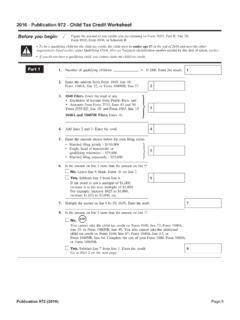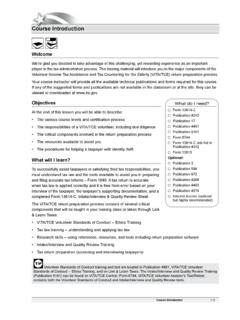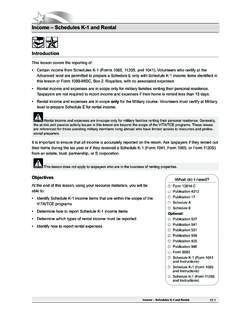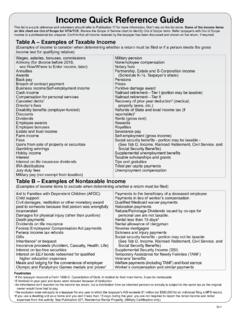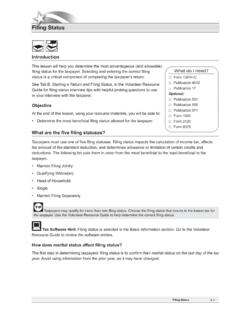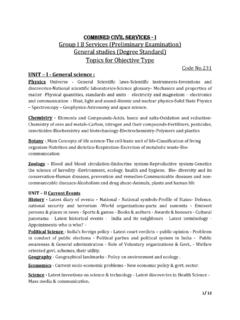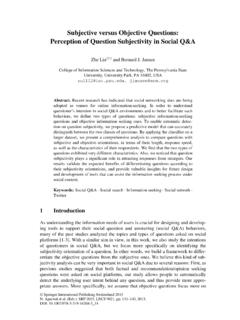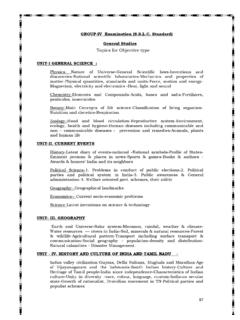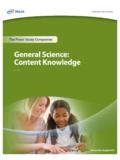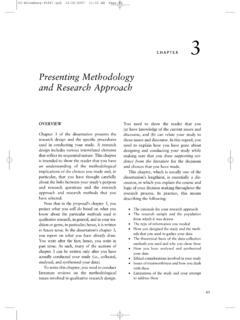Transcription of Introduction Objectives Topics - Internal Revenue Service
1 Page 1 Income Business Time Required: 20 minutes Introduction Objectives Topics This lesson will help you prepare an accurate return for taxpayers who have business income, including self-employment income. Form 1040 is used to report income from a business or profession operated as a sole proprietor or independent contractor. Determine: How to report business income What business expenses are within the scope of the VITA/TCE program How to complete Schedule C Identify "red flags" when preparing a Schedule C tax return with EIC What records to maintain Business Income or Loss Information Reporting Business Income Schedule C in Scope for VITA/TCE Clarifying Taxpayers' Business Income and Expenses Business Expenses Completing Schedule C Recordkeeping Key Terms Actual Expense Method: One of two methods for calculating business automobile expenses.
2 For the actual expense method, the taxpayer determines the business portion of expenses for fuel, auto maintenance, parking fees and tolls, and auto loan interest. (The other method is the standard mileage method.) The actual expense method is out of scope for the VITA/TCE program. Business Expenses: Business expenses are amounts that are ordinary and necessary to carry on the business. Business Income: Business income is income received from the sale of products or services . For example, fees received by a professional person are considered business income. Rents received by a person in the real estate business are business income. Payments received in the form of property or services must be included in income at their fair market value. Cash Method of Accounting: Accounting method that reports income when constructively received (not earned) and expenses when paid (not incurred), as opposed to the accrual method.
3 Depreciation: The cost of items that are expected to last more than a year should be spread over a period of years rather than deducted in the year of purchase. In-scope for Military certification only (rental property). Earned Income: Any income received for work, such as wages or business income. Election to expense business assets: An election is available to immediately expense qualifying business assets. Taxpayers who wish to expense business assets should be referred to a professional tax preparer. Employee: Under common-law rules, anyone who performs services for you is your employee if you can control what will be done and how it will be done. This is so even when you give the employee freedom of action. What matters is that you have the right to control the details of how the services are performed. Independent Contractor: People who are in an independent trade, business, or profession in which they offer their services to the general public are generally independent contractors.
4 The general rule is that an individual is an independent contractor if the payer has the right to control or direct only the result of the work and not what will be done and how it will be done. The earnings of a person who is working as an independent contractor are subject to self-employment tax. Income Business page 2 Inventory: The items the taxpayer buys or makes for resale to others. Taxpayers having inventory should be referred to a professional tax preparer. Qualified Business Income deductions: Beginning in 2018, taxpayers may be able to deduct up to 20% of their qualified business income from their business. The deduction can be taken in addition to the standard deduction or itemized deductions. Qualified Medicaid waiver payments: Payments by a state, a political subdivision of a state, or a certified Medicaid provider under a Medicaid waiver program to an individual care provider for nonmedical support services provided under a plan of care to an individual (whether related or unrelated) living in the individual care provider s home.
5 Regular Method: Most common method for computing self-employment tax. Under the regular method, the net self-employment income entered on Schedule SE is the sum of net self-employment earnings from the taxpayer's Schedules C and F. (Taxpayers should consult a professional tax preparer or a military legal assistance officer if they use a different method or require Schedule F.) Ride Share services : Taxpayers who use their automobiles for hire or ride share services such as Uber, Lyft, Sidecar, etc. Self-employment Income: Earned income from a trade, business, farming, or profession that is not paid by an employer. For example, seamstresses and lawn care workers who work for themselves (and not for someone else) are considered self-employed. Sole Proprietor: (See independent contractor.) Standard Mileage Method: One of two methods for calculating business automobile expenses.
6 For the standard mileage method, the taxpayer multiplies the business miles by the mileage rate for that tax year. (The other method is the actual expense method). Statutory employee: If workers are independent contractors, such workers may nevertheless be treated as employees by statute (a statutory employee) for certain employment tax purposes. Teacher Tips Guidelines for Lesson Guideline Instructor Notes Presentation Aids Lesson background info Review the online demo of TaxSlayer on reporting business and self-employment income. TaxSlayer Demo: From the Practice Lab, select : TaxSlayer IRS training Click the appropriate demo Provide details and engage the students Discuss all tips and cautions in detail. Ask students to read and/or role-play examples. Review answers to each exercise; ask students how they arrived at their answers. Internet: Link & Learn Taxes (L<) Income Business Income Business page 3 Topic-specific Tips Topic Name Instructor Notes Presentation Aids Introduction Review lesson Objectives .
7 Review list of references. State the presentation time. Review Key Terms for the lesson. Review the Tax Topics found on Review what lines on Form 13614-C impact business income. Remind students that preparation of tax returns with Schedule C are in scope for VITA/TCE when the return meets specific limits. Ask students to explain if they know the difference between an independent contractor and an employee (see Pub 15-A). Visuals: Form 1040 Form 13614-C, Page 2, Part III Schedule C Schedule SE Pub 15 Pub 15-A Internet: Tax Topics : Business Income Tax Topics : Small Business/Self-Employed Tax Topics : Independent Contractor vs. Employee Business income or loss information Review L< topic Business Income or Loss Information. Prompt students to share what they know about business income using the questions from the topic. Ask students what type of follow-up questions they should ask taxpayers to determine if the taxpayer or spouse had business income.
8 Ask: What are sources of business income information? Answer: Form 1099-NEC (Nonemployee compensation) and Form W-2 (Statutory Employee), Form 1099-K, (Ride share economy such as Lyft, Uber, etc), and taxpayer records. Point out that cash payments received by self-employed taxpayers must be included in their business income on Schedule C. This is true even if the income is not reported on Form 1099-NEC or Form 1099-K. Caution students that some employers misclassify workers as independent contractors and report their earnings on Form 1099-NEC. Visuals: Form 13614-C, Page 2, Part III Form 1099-MISC Form 1099-NEC, Box 1 Form W-2, box 13 Form 1099-K Internet: L< Business Income, Business Income or Loss Information FAQs: Form 1099-MISC & Independent Contractors Bulletin: Notice 2014-7 Income Business page 4 Reporting business income Review L< topic Reporting Business Income.
9 Ask: What does TaxSlayer do with the income and expenses entered into Schedule C? Answer: TaxSlayer calculates and applies the net profit to the correct line on Schedule SE and computes the self-employment tax. Amounts are then transferred to the correct lines of Form 1040. Present TaxSlayer training tutorial on Business Income up through entering Form 1099-NEC income into Schedule C. Visuals: Schedule C Internet: L< Business Income, Reporting Business Income TaxSlayer Demo: From Form 1040, click Schedule C Click applicable line from Form 1040 view or click Income from Federal Section>Form 1099- NEC. Schedule C in scope for VITA/TCE Review L< topic Schedule C in scope for VITA/TCE. Ask: What are the conditions for Schedule C to be within scope for VITA/TCE? Emphasize that before starting to prepare the return, the volunteer must determine if the business qualifies to be reported on Schedule C.
10 This means estimating business income and expenses. Remind students self-employment taxes are computed on Schedule SE for net earnings of more than $400. State that self-employment tax is automatically calculated in TaxSlayer. Inform students that Schedule SE is covered in the Other Taxes lesson. Visuals: Schedule C Form 13614-C Form 1040, Schedule SE Internet: L< Business Income, Reporting Business Income Tax Topics , Self-Employment Tax Clarifying Taxpayers' Business Income and Expenses Review L< topic Clarifying Taxpayers' Business Income and Expenses. Ask: What are situations that raise a "red flag" for a volunteer preparing a tax return with Schedule C and EIC? Emphasize that a taxpayer must be prepared to provide receipts and other documentation to support their claimed business income and expenses. Ask students to read aloud the sample interview and discuss why the information Dana provides is inconsistent and incomplete.




